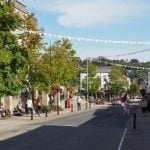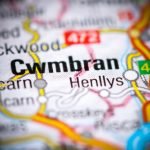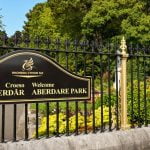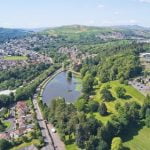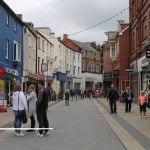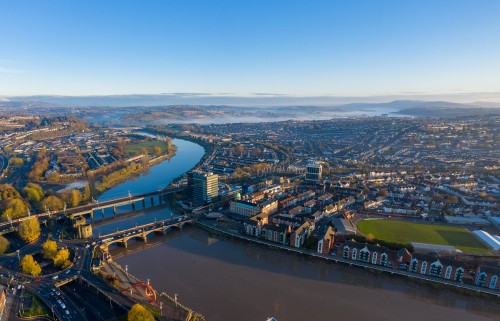
A quick guide to Newport!
Newport is a city and unitary authority area in southeast Wales. It’s situated on the banks of the River Usk, close to its confluence with the estuary of the River Severn. The city also lies some 12 miles (19 km) northeast of the Welsh capital, Cardiff. It’s also 30 miles (48 km) northwest of the major English city of Bristol. In the 2011 census, Newport was found to be the third-largest city in Wales, with a population of 145,700. The city also forms part of the Cardiff-Newport metropolitan area which has a population of some 1.1 million.
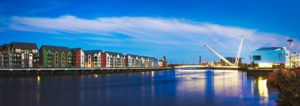
Panoramic view of Newport’s Riverfront with the Millenium Bridge over the River Usk
A Fleeting History
Early Times
The Romans were the first to settle in the Newport area when they built a fort at Caerleon, about 5 miles northeast of Newport. It was the headquarters for Legio II Augusta from around 75 to 300 AD. On the hill above was the site there also once stood an Iron Age hillfort. However, the settlement of Newport only came about after the Normans conquered Gwent in 1093. By the early 12th century the Normans had built a castle at a ford crossing of the River Usk. A settlement soon grew up around the castle which provided a ready market for goods. Hence, the beginnings of Newport had begun.
By the end of the 12th century, the first crossing of the River Usk was completed in the form of a wooden bridge, greatly enhancing local connectivity. In 1385, Newport was given its first charter, guaranteeing the townsfolk certain rights, which included the privilege to elect an official (burgess) to oversee the day-to-day running of the town and to form a ‘trade guild’.
A Flourishing Port
By this time, the River Usk was the local conduit for the import and export of goods. Wool, hides, cloth, and foodstuff were transported in small boats from the port at Caerleon to larger, more developed ports, which more often than not, was Bristol. The earliest records show that in 1397, John Banham, the burgess of ‘Newport-on-Usk’, was responsible for shipping wool down the river.
During the 16th century, Newport remained a small port town. In 1521, a Survey of the Estates of the Duke of Buckingham described the River Usk as being “well occupied with small crays where a great ship may resort and have good harbour”. In 1587, the wooden bridge over the River Usk collapsed and had to be rebuilt. Newport was awarded a new town charter in 1623, a recognition of its growing importance. However, even by 1700, Newport was still only a small town with a population of less than 1,000.
Early Industrialistion
However, at the end of the 18th century, with the arrival of the industrial revolution, Newport was about to undergo a massive transformation. The coal and iron industries in South Wales began to boom and ever-increasing amounts of ore were produced for export through Newport. In 1798, the construction of a canal was completed to facilitate shifting coal and iron ore from the mines to Newport. From 1823 onwards, to cope with the demand for coal and iron ore, it became necessary to operate steamships between Newport to Bristol. As a result, Newport’s 1801 population of just over 1,000, had grown to more than 7,000 by 1831, and to around 19,000 by 1851.
The Newport Rising
On 4 November 1839, the ‘Newport Rising’ took place when 10,000 ‘Chartist’ sympathisers, led by John Frost, marched on Newport. The Chartists main cause was for ‘the vote’ to be extended to all men, not just landowners. The mostly working-class men were intent on liberating fellow Chartists, who were reported to have been taken prisoner in the town’s Westgate Hotel. Troops opened fire on the demonstrators, reportedly killing 22 people.
The 3 main leaders of the rebellion, including Frost, were convicted of treason and sentenced to be hanged, drawn, and quartered. The sentences were later commuted to transportation to Australia. However, in 1856, Frost was given an unconditional pardon and allowed to return to Britain. He received a triumphant homecoming in Newport, and though he never lived in the town again, he did carry on pressing for social reform right up to his death in 1877, aged 93.
Boom Town
In October 1842, Town Dock opened, greatly increasing the town’s port facilities. Exports, of coal, steel, and iron, in particular, grew rapidly. Newport quickly became the main industrial centre within the Welsh Valleys.
The railway came to Newport in June 1850, when the South Wales Railway began operating train service between Chepstow and Swansea. In 1854, an extension to Town Dock began, allowing for an increase in trade. However, demand could still not be met, and consequently, the much larger Alexandra Dock was opened in April 1875. This was followed by a third; South Dock, in June 1893.
Facilities in Newport also continued to improve, with Gwent hospital opening in 1901, and the first public library, in 1871. From 1875, horse-drawn trams ran on the streets, Belle Vue Park opened in 1894, and the first electricity generating station opened the following year. In the late 19th century, the town’s population continued to grow rapidly, reaching 35,000 in 1881, and almost doubling to 67,000, by 1901. To accommodate the growth, the boundaries of Newport had by this time, extended east of the river
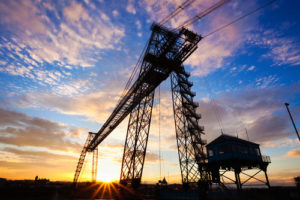
Newport’s Transporter Bridge – 1 of 2 still operational in the UK
Tragedy and Decline
To the contrary, the docks, which had enjoyed great success during the 1800s, began to decline in the early 1900s. The Newport Dock Disaster of 2 July 1909 didn’t help the situation. During work on the extension of Alexandra Dock, 46 men working at the bottom of a trench were buried when shoring collapsed. While a few men were rescued, 39 died on that fateful day.
The town’s horse-drawn trams were replaced by electric trams in 1904. The Newport transporter bridge went into operation in 1906. However, in 1914, the town’s dockyard activity took a downturn, as the outbreak of WW1 and conscription, meant there was a lack of available manpower in the town.
Newport suffered economically during the Great Depression, leading to the Town Dock’s closure in 1930. However, despite the economic conditions, the local authority embarked on an ambitious council house building programme during the 1920s and 1930s, with slum clearance taking place across the town. In 1935, the town boundaries were extended once again. In 1937, the town’s electric trams were replaced by buses. By 1939, the population of Newport had reached 100,000.
World War Two
In 1945, the advent of WW2, saw the town’s industries begin to boom again, thanks to the country’s need for coal and steel. However, this then made the town a target for the Luftwaffe. Thus, between June 1940 and the end of 1941, bombs were dropped with regularity on Newport, mainly at industrial targets. One of the worst attacks happened on 1 July 1941, when bombs fell on the Maindee, Eveswell, and Beechwood districts, killing 37 and injuring 42. After 1941, the Germans concentrated their efforts on Russia. Thus, sparing Newport further attacks.
In 1949, St Woolos Church was granted cathedral status. Hence it became known as St Woolos Catherdral and later as Newport Cathedral.
The Modern Era
The post-war years saw prosperity return to Newport, and while some of the town’s old-established industries began to close, other industries took their place. In 1962, the Llanwern Steelworks opened, however, the export of coal shifted from Newport to Barry, only two years later. The construction of the Severn Bridge and local sections of the M4 motorway in the late 1960s, saw Newport become the best-connected place in Wales. However, in 1975, imports of iron were moved to Port Talbot, while shipbuilding ended around the same time.
The Library Museum and Art Gallery were built in 1968, and the Kingsway Shopping Centre was built in the early 1970s. And, while employment at Llanwern steelworks declined in the 1980s, new public sector employment opportunities arose. In 1982, the Inmos microprocessor factory, designed by renowned architect Richard Rogers opened. It helped to establish Newport as a centre of excellence for technology companies.
In 1991, the Chartist Statues were unveiled in Newport, along with the Steel Wave sculpture. And, in 1992 Newport’s bizarre clock entitled, In the Nick of Time, was built. That was followed up in 1994 by the sculpture of a pig called ‘This Little Piggy Went to Market’. The Bell Carrier sculpture was unveiled in 1996.
In 2002, the county borough of Newport was granted city status to mark Queen Elizabeth II’s Golden Jubilee. Also in 2002, an ancient merchant ship, now referred to locally as the Newport Ship, was uncovered on the west bank of the River Usk during the construction of the Riverfront Arts Centre. The conserved vessel, dated between 1445 and 1469, remains the only ship of its type discovered anywhere in the world.
In 2007 and 2008, the Kingsway Shopping Centre underwent major extension and refurbishment.
Newport is currently internationally twinned with Heidenheim, Germany (since 1990) and Kutaisi, Georgia (since 1989).
Getting There!
By Road
Getting to Newport by car from England and Scotland couldn’t be easier! Just get on to the motorway network and head for the M4, via the M5 and M6. It takes you to the very outskirts of the city. If you’re travelling from North Wales, then take the A49.
By Bus
Inter-city National Express services run from a stop near the Riverfront arts centre opposite the bus station and Megabus (Europe) services operate outside of Newport Railway Station.
By Train
The Great Western Railway (GWR)line connects the city with Bristol, London Paddington, and Pembroke Dock. The Welsh Marches line connects with Holyhead, Manchester Piccadilly, and Llanelli. The Gloucester line connects the borders region including Cheltenham. The Wessex Main Line provides an hourly service from the city to Portsmouth. There are 5 or 6 trains an hour to/from nearby Cardiff, 2 or 3 trains an hour to/from Bristol, and up to 4 trains an hour operating between London and Newport.
By Air
The nearest airport to Newport with domestic and international flights is Cardiff. The airport is 30 miles (48 km) southwest of Newport, which is a 35-minute car or 55-minute train journey.
Getting Around!
Bus services are primarily provided by the municipally funded Newport Bus company, and neighbouring firm Cardiff Bus. Other operators include FoxStar Bus, Stagecoach (South Wales), and New Adventure Travel (NAT). The city is also well connected to both Cardiff and Bristol, with buses leaving/arriving every 10 to 15 minutes.
A Famous Son
Poet and author William Henry Davies, probably better known as W. H. Davies (1871 – 1940) was born at 6 Portland Street, Pillgwenlly, Newport. Davies spent a good part of his life as a tramp or hobo, in both the UK and USA, but it didn’t stop him from becoming one of the most popular poets of his time. His works reflect observations made on life’s hardships, the human condition, and his own tramping adventures. Davies is usually classed as one of the ‘Georgian Poets’ although much of his work is said to be untypical of the genre.
Little known facts about Newport!
- It’s little known, that arguably, the most famous/infamous escapologist who has ever lived; Harry Houdini loved Newport. So much so, that the Budapest-born, Detroit-raised star chose Newport to kick off his very first international tour in 1905. It was held at the city’s Lyceum Theatre, which at the time was the biggest indoor venue in Wales.
- Newport lays claim to being the first place to serve up a dietician’s nightmare takeaway dish – curry sauce, cheese, and chips!
- The speed camera on the A4042 at Kingsway is reputedly the second highest-grossing in the UK.
What’s in a Name?
Did you know that there are 56 places around the world that have the name ”Newport”? Fourteen of those are in the UK, while another thirty-three are in the USA. A total of 56 Newports in the world might sound like quite a lot. However, the world’s most prolific name place belongs to the moniker ”San Jose”, of which there are 1,716. Little wonder singer Dionne Warwick was asking ‘Do you know the way to San Jose?’ back in the 1960s.
Places to Visit
Some of the recommended places to see in Newport include:
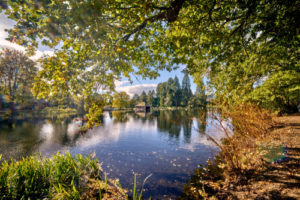
The historic gardens of Tredegar House
- Roman Caerleonis – a historical roman site located in the town of Caerleon, near Newport, It’s run by the Welsh historic environment service.
- Transporter Bridge – Grade I listed structure, one of fewer than 10 such bridges in the world – only a few dozen were ever built!
- Tredegar House – Grade I listed, a 17th-century Charles II-era country house mansion in Coedkernew, stands in 90 acres of cultivated gardens.
- Newport Medieval Ship – a mid-15th-century sailing vessel discovered by archaeologists in June 2002. The restoration of the ship is currently ongoing.
- Newport Museum and Art Gallery – opened in 1888, collections include Archaeology, Social History, Art, and Natural History.
- St Woolos (aka Newport) Cathedral – dating back to the 9th century it is the seat of the Bishop of Monmouth.
- Newport Wetlands Reserve – is a wildlife reserve covering parts of Uskmouth, Nash, and Goldcliff.
Places to stay?
There’s plenty of accommodation in Newport to suit almost all tastes and budgets, with rooms being at the cheap end of the scale across the country as a whole. A broad indication of prices for commonly available accommodation in the Newport area is:
B & B/Guesthouses/Standard Hotels: £30 – £70
3/4/5 Star Hotels: £70 – £180
Holiday Home/Apartments: £130 – £200 (between 2 & 6 adults sharing)
